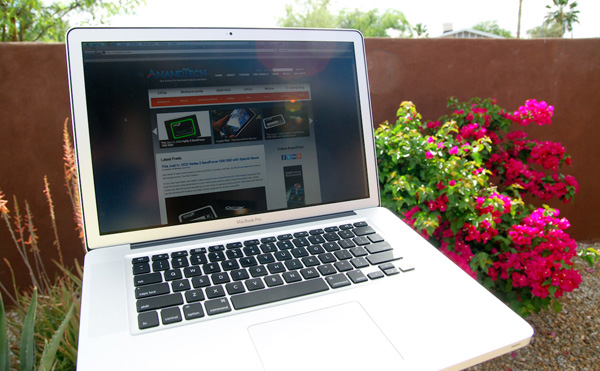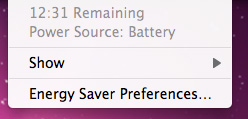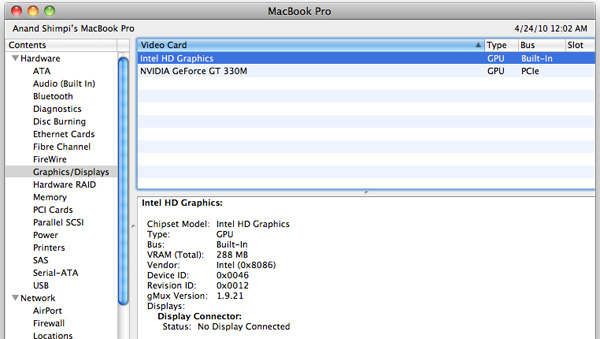Apple's 15-inch 2010 MacBook Pro: More Battery Life Tests, High Res Display Evaluated
by Anand Lal Shimpi on April 24, 2010 1:57 AM EST- Posted in
- Mac
- Displays
- MacBook Pro
- Arrandale
- Laptops
Apple is in a position that’s enviable by any consumer facing company. It drums up genuine excitement for nearly every product it launches. Apple has somehow found a way to make something as small as just another processor refresh exciting.
It’s not all smoke and mirrors though. The previous generation unibody MacBook Pro posted some incredible battery life numbers. And two weeks ago Apple paired it with Intel’s Core i5 and i7 mobile CPUs, delivering the sort of desktop-like performance we’ve been waiting for.

Since the release we’ve had the time to answer a few more questions about the new systems. We updated our launch article with Core i5 vs. Core i7 results. But today, in response to many of your requests, we’ve got more battery life results and a full evaluation of the 15-inch MacBook Pro’s display quality. Apple is often the go-to manufacturer for creative professionals, we put our colorimeter on the MacBook Pro to find out if they’re making the right choice.
Battery Life: Better and Worse in the Real World
Battery life on the new MacBook Pro is a lot more varied than it was on the old one. While our light web browsing test does a good job of showing you what very light usage can give you, I find that the new 15-inch MacBook Pro spends more time at states of higher power draw than the old one. This is difficult to show as a single benchmark result but it appears to be because of two things.

The obvious cause is that the Core i5/i7 CPUs let you do more with the machine. Tasks complete quicker, the system is more responsive and as a result you end up doing more with the machine.
The second part of the problem is Apple’s automatic graphics switching technology. While it relies on applications that use specific frameworks (e.g. OpenGL, OpenCL, Quartz Composer, Core Animation and Core Graphics), many have pointed out strange behavior when doing something as harmless as browsing the web.
An attentive Mac Rumors reader pointed out that by looking at OS X’s System Profiler you can find out what GPU is being used: the active GPU will list the specs of the display it’s driving:

The inactive GPU will simply state that there’s “No Display Connected”. Start up Photoshop and you’ll see the discrete GPU kick in, close it and you’ll see Intel’s HD Graphics take over.

Readers of my first Month with a Mac article will know that one thing I quickly embraced about OS X was the idea of just leaving applications open. If you’ve got enough memory, OS X tends to do just fine with a ton of applications open. In fact, the UI is designed around it; closing all application windows rarely quits the app itself, Apple appears to want you to leave your frequently used apps open and idle. It makes switching between them that much faster. The fact that the new MacBook Pro’s discrete GPU won’t power down if you have an application like Photoshop open flies in the face of this leave-your-apps-open usage model.
So you’ve got to be mindful of what applications will trigger the discrete GPU to take over. That’s not terribly hard, but there’s just one problem: sometimes your web browser can wake up the dGPU. I’ve found numerous cases where Google Chrome will activate the discrete GPU, while our own Brian Klug found that Firefox did the same. I haven’t extensively tested Safari to see if it has the same issue. I suspect this is a software bug, but it is one that lowers battery life in real world usage scenarios. The discrete GPU remains powered down in all of my OS X battery life tests, but I found that in my using the new MacBook Pro my battery ran down much quicker than I was expecting. Part of it is the potentially more power hungry Arrandale CPU, but part of it is the fact that the discrete GPU was active when it had no reason to be.
You’ll still get better battery life compared to an older MacBook Pro, and you have the potential to get better battery life than last year’s 2nd gen unibody MacBook Pro. But as I mentioned in our review, there’s also the chance that you’ll see lower battery life than the previous model. And as I’ve come to realize, that chance is higher than I originally thought because of the issues mentioned above. It's even higher if you opt for the Core i7 model...










69 Comments
View All Comments
Anand Lal Shimpi - Saturday, April 24, 2010 - link
Thank you!Take care,
Anand
BanditWorks - Saturday, April 24, 2010 - link
I don't have the new MacBook Pros, but I do have a year old regular MacBook and while I was giving the new Adobe Flash 10.1 beta (the one that utilizes the GPU and CPU) I definitely saw a noticeable difference in battery life.As I wasn't doing anything that intensive on my MacBook I went back to the most stable version of Flash and it felt as if I had installed a newer, longer lasting battery instantaneously.
PS - Yeah, glossy screens suck big time. They're as tacky as a car with everything chromed out. They may be nice to look at when the screen is turned off, but for everything else they don't really serve much of a purpose in my opinion.
Computer Scooter Joe - Saturday, April 24, 2010 - link
Anand,You mentioned under windows the dGPU will always be on. In regards to this i have two questions:
1) Are there any heat issues with the dGPU being on all the time? Does the laptop get especially hot?
2) Do you foresee being able to enable graphics switching under windows? (Be it via Apple or a hack/3rd-party program)
I'm going to be attending University in the fall and i really like the aesthetics of the Macbook Pros; but these two questions have me a little worried. Having tried it, I must admit, I really do not like OSX at all (yes i know, blasphemy and all that), and i plan on bootcamping Windows 7. Price is not an issue; performance (or lack thereof) is what matters.
PS: To other commenters, please do not flame and start saying "Go buy Laptop X from this other company, Mac's are overpriced."
Thanks in advance.
Brian Klug - Saturday, April 24, 2010 - link
I can't speak entirely for the dGPU temperature in Windows 7 or boot camp installed OSes, but I do think I can talk a little about the dGPU temperature because I find myself switched on it a lot for what I do.I run a lot of Matlab related software on OS X (as I'm also a student), which requires an X11 instance. It seems that the X11 window system on OS X inevitably calls one of those core libraries that triggers the discrete GPU switching, and usually I don't notice until a good hour or so later that I'm on the dGPU. You'll notice that the battery life estimate changes. It doesn't immediately dramatically suffer, but it just seems shorter. Temperature creeps up a bit, but in practice for what I'm doing being switched on the dGPU doesn't raise internal temperatures more than 15 degrees F. I'd imagine playing games or doing some heavy OpenGL loads would change that though.
Apple has done a pretty good job with the thermal management from what I've seen thus far. I've had a couple of eyebrow-raising moments burning in the matte MBP I used for the display review section, but it's important to understand that temps up to 200F (while admittedly INSANE IMO) are well within the T_junction spec from the i7 spec sheet. The CPU will throttle long before you do any physical damage.
-Brian Klug
solipsism - Saturday, April 24, 2010 - link
Thanks for the review.I know that there is a Sys Pref option to keep the dGPU on all the time, but there is no power saving option to disable the dGPU completely. Did you find a secret switch, like in an PLIST file that will allow this to happen. This would come in handy for long bouts without a power cord attached.
etikka - Saturday, April 24, 2010 - link
Hi,Thank you for the review.
It would be great to have a review on the Macbookish HP envy 15". The looks are ok and it would be great to have a quad core CPU and working GPU switching under Win7.
MySchizoBuddy - Saturday, April 24, 2010 - link
offtopicSo Matlab is still using X11 on Mac OS X. I think they were working on a mac native version I guess they haven't released it yet
Brian Klug - Saturday, April 24, 2010 - link
See I agree completely! There needs to be a native version already. I haven't investigated it a lot, but it could be related to the 64-bit version I'm running. I'm on 2010a.I did some reading a while ago and the consensus was that Matlab on OS X just runs a LOT slower. Almost twice as slow in some cases. It isn't so much a problem stemming from the X11 window session rendering pipeline, but the java swing rendering pipeline. I'm puzzled why the platform is getting so little attention from the Mathworks when I see a huge population of students with exclusive mac setups. Oh well.
There's an awesome (bit dated though) thread here: http://www.macresearch.org/matlab-and-os-x
-Brian
ken.atwell - Friday, May 7, 2010 - link
I work for The MathWorks and a little while back I blogged about MATLAB on the Mac, including MATLAB's (diminishing) dependency on X11 . The performance of MATLAB on the Mac platform is also discussed, though you need to dig into the comments a bit (comment #12). If you are interested in these topics, you may want to visit:http://blogs.mathworks.com/desktop/2009/08/31/poun...
Ken Atwell
damianrobertjones - Saturday, April 24, 2010 - link
Thank you for the info, but, when are you going to review or run ANY articles with regards to the new Fujitsu, HP and Toshiba i7/i5 Tablets which are brand new and just out......Why don't they/haven't they been mentioned at all?